
Top 10 Renovations to Make to a Spanish Property
Whether you’re living full-time in Spain or using your property as a holiday home or rental, upgrading a home on the Costa del Sol comes
We help homes and businesses live in a more cost-effective and environmentally friendly way, by installing cleaner renewable energy solutions, such as Solar Panel Systems, Heat Pumps, and Home Car Chargers.
Our quality of service is why we’re the number one renewable energy solutions provider in Spain.
Solares Energies brings together the passion, skill, and knowledge of renewable energies to advise our clients on the best green energy solutions and products, to meet their needs. We offer greener energy solutions from Solar Panels, Home EV Charging Points, Heat Pumps and more.
Our professional team are here to talk you through all of the green solutions available to help you reduce your utility costs and to help reduce your carbon footprint. Based near Marbella in Malaga, our project managers will manage your installation from inception to completion, to ensure everything runs smoothly. Our quality of service is why we’re the number one renewable energy products provider in Spain.
At Solares Energies, we care about the environment and believe that everyone has a part to play in making Spain a little greener, using Green Renewable Energy Products and Solutions, such as Solar Panels with Battery Storage, Heat Pumps, Electric and Biomass Boilers and EV Car Chargers.
Whilst using greener renewable energy sources, the team at Solares Energies are striving to engage with more homes and families to promote a greener way of living, to help sustain the way we live, for our children and the planet. We promote the use of renewable energy solutions and products whenever and wherever possible.
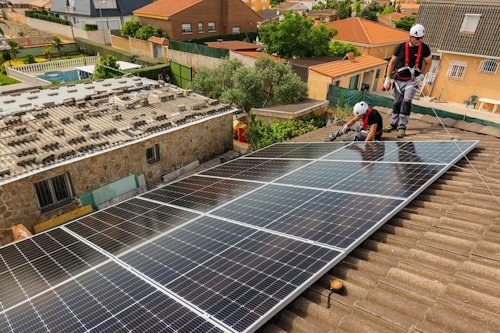
If you’re looking for the best Renewable Energies Spain has to offer, then look no further than Solares Energies. We’ll provide you with all the necessary information to make the switch as easy and stress-free as possible. Based near Marbella on the Costa Del Sol, our friendly, qualified team is here to help. – We have professional, fully trained installation technicians based throughout Malaga and Cadiz, so no matter where you are, we will be able to help. Solares Energies provides sustainable and innovative energy solutions and products to homes and businesses throughout Spain. Our team of experienced professionals are committed to creating a cleaner, more, energy-efficient future powered by renewable energy solutions and products.
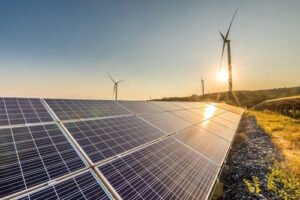
With years of experience in the renewable energy industry, we’ve helped countless home and business owners switch to green energy solutions that not only save them money on their energy bills but also make a positive impact on the environment. We offer a wide range of green renewable solutions and services, including solar panels, electric vehicle car charging points, heat pumps, enhanced geothermal systems, and more.
At Solare Energies, we understand that every customer is unique, and that’s why we take a personalised approach to every project we take on. Our team of experts will work with you to assess your energy needs and budget and develop a custom solution that best suits your needs.
We’re committed to making the transition to renewable energy as easy and seamless as possible for our customers. From the initial consultation to the installation process and ongoing maintenance, we’re here to provide you with the support and guidance you need, every step of the way.
So, if you’re ready for the clean energy revolution and to make the switch to clean, sustainable energy, look no further than Solares Energies. Contact us today to schedule your consultation and take the first step towards a brighter, more green sustainable future.

All our installation technicians are fully qualified in their relevant fields, with years of experience in, installing renewable energy solutions, such as Solar Panels & EV Charging Points.

Our team have over 15 years of experience within the renewable solutions field. We have a wealth of knowledge and we’re constantly looking at new and improved technologies.

Our friendly and reliable, English and Spanish speaking team are here to help. We’re a family run business who are here to help you get the best solutions to save on utility bills.







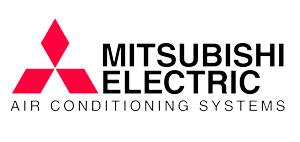
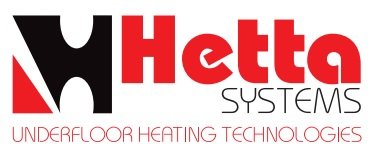
Solares Energies provides sustainable and innovative energy solutions and products to homes and businesses throughout Spain. Our team of experienced professionals are committed to creating a cleaner, more, energy-efficient future powered by renewable energy solutions and products.

With years of experience in the renewable energy industry, we’ve helped countless home and business owners switch to green energy solutions that not only save them money on their energy bills but also make a positive impact on the environment. We offer a wide range of green renewable solutions and services, including solar panels, electric vehicle car charging points, heat pumps, enhanced geothermal systems, and more.
At Solare Energies, we understand that every customer is unique, and that’s why we take a personalised approach to every project we take on. Our team of experts will work with you to assess your energy needs and budget and develop a custom solution that best suits your needs.
We’re committed to making the transition to renewable energy as easy and seamless as possible for our customers. From the initial consultation to the installation process and ongoing maintenance, we’re here to provide you with the support and guidance you need, every step of the way.
So, if you’re ready for the clean energy revolution and to make the switch to clean, sustainable energy, look no further than Solares Energies. Contact us today to schedule your consultation and take the first step towards a brighter, more green sustainable future.
We supply Renewable energy solutions for both commercial and residential customers in Spain.! For the home or business, solar panels are one of the most popular and most reliable renewable energy products, that will not only reduce your carbon footprint but save you €1000’s in energy costs. Solar energy is generated from sunlight and can be used to generate electricity for the home or business. Wind turbines are also a popular option, especially in windy areas. Other options include biomass boilers, geothermal energy, small-scale hydroelectric power, tidal power, hydropower, and biomass systems.
Several renewable energy products are suitable for residential homes. Some of the best renewable energy products for homes include:
The best renewable energy product, for a home, depends on a variety of factors, including the location, climate, and energy needs of the home. It’s important to consult with a professional to determine the best renewable energy solutions for your specific situation. See: Commercial Solar Panels
Green energy, or green power, represents the energy sources that have the least amount of environmental impact. These types of clean energy future sources don’t release harmful carbon emissions, meaning they’re effective at helping you reduce your carbon footprint. Some examples of green energy include electricity produced from solar, wind, geothermal and other low-impact sources.
Some examples of green energy include electricity produced from solar, wind, geothermal and other low-impact sources.
Renewable energies are also more reliable than traditional energy sources. For example, solar power and wind power can both be harvested in almost any part of the world, making them far more reliable than other forms of energy such as natural gas or petroleum. Renewable energies are becoming increasingly affordable as technology advances and costs decrease. “Take advantage of the Spanish sun and save €1000s on energy bills with Solar Panels“.
Using renewable energy is one of the most effective ways to reduce your carbon footprint and help combat the effects of climate change. It’s also a great way to save money on energy bills, as well as create jobs in renewable technologies and energy-related industries. By choosing green energy solutions for your home, business or community, you can make an impact on the environment and help us all.
Renewable Energy: Renewable energy refers to energy generated from sources that naturally replenish over human timescales. These sources include sunlight (solar power), wind, rain (hydroelectric power), tides (tidal power), waves (wave power), and geothermal heat. Biomass, which is organic material that comes from plants and animals, and can be continually replenished, is also often considered a source of renewable energy. The key element of renewable energy is its ability to be continually restored.
Green Energy: Green energy, on the other hand, refers specifically to types of energy that are not only renewable but also have minimal negative impacts on the environment as compared to conventional fuels like coal or oil. Green energy sources produce little to no greenhouse gases or pollutants and are sustainable from an environmental perspective.
So while all green energy is renewable, not all renewable energy is considered green. For example, biomass energy is renewable because we can always grow more trees and crops, but it’s not always green because burning biomass releases carbon dioxide and can contribute to deforestation. Similarly, large-scale hydroelectric dams are renewable, but they can have significant environmental impacts, including altering ecosystems, displacing communities, and contributing to greenhouse gas emissions from rotting vegetation in flooded areas.
As such, renewable energy is a broader term, encompassing all energy sources that are naturally replenishing, while green energy specifically refers to those renewable energy sources and processes that cause minimal environmental impact.
There are several reasons why using renewable energies can be beneficial:
Environmentally Friendly: Renewable energies produce little to no greenhouse gas emissions, which are a major contributor to climate change. By using renewable energies, you can help reduce your carbon footprint and contribute to a more sustainable and environmentally friendly future.
Reduced Energy Costs: While the upfront costs of installing renewable energy systems can be high, renewable energies can ultimately save you money in the long run by reducing your reliance on expensive and volatile fossil fuels.
Energy Independence: By generating your own renewable energy, you can reduce your dependence on external sources of energy and increase your energy independence.
Job Creation: The transition to renewable energies creates new jobs in the clean energy sector, which can help boost local economies.
Energy Security: Renewable energies are sustainable and do not deplete over time, which can provide greater energy security for individuals, communities, and countries.
Public Health: Traditional fossil fuel-based energy production is often associated with air pollution and related health issues. By reducing the number of fossil fuels used in energy production, renewable energies can help improve public health.
Using green renewable energies can help create a more sustainable and environmentally conscious, energy supply system, while also providing economic and social benefits.
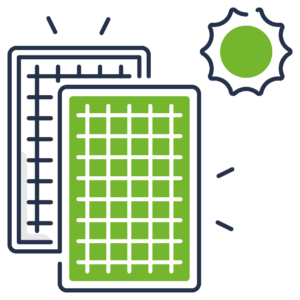 At Solares Energies, we understand that the world of renewable energy can be vast and sometimes complex. That’s why we’ve compiled a comprehensive list of the most commonly asked questions about renewable energies and our range of renewable energy products and services. This resource is designed to provide you with quick and clear answers, helping you understand how renewable energy can benefit you and the environment. Our FAQ section covers topics from solar panels and wind turbines to energy storage and efficiency and everything in between.
At Solares Energies, we understand that the world of renewable energy can be vast and sometimes complex. That’s why we’ve compiled a comprehensive list of the most commonly asked questions about renewable energies and our range of renewable energy products and services. This resource is designed to provide you with quick and clear answers, helping you understand how renewable energy can benefit you and the environment. Our FAQ section covers topics from solar panels and wind turbines to energy storage and efficiency and everything in between.
If your question isn’t covered in our FAQs, we’re here to help. Our team of renewable energy experts is dedicated to providing you with the information you need. Whether you’re curious about the installation process, cost savings, environmental impact, or the specific products and services we offer, don’t hesitate to reach out to us. Contacting Solares Energies is easy and we’re always eager to assist you in exploring renewable energy solutions that are tailored to your needs. Let us guide you towards a more sustainable and energy-efficient future.
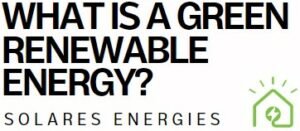 Green renewable energy refers to energy sources that are environmentally friendly and sustainable, meaning they can be replenished naturally and do not deplete over time. These energy sources are considered “green” because they have a minimal or no adverse impact on the environment compared to conventional energy sources like fossil fuels. Key characteristics of green renewable energy include:
Green renewable energy refers to energy sources that are environmentally friendly and sustainable, meaning they can be replenished naturally and do not deplete over time. These energy sources are considered “green” because they have a minimal or no adverse impact on the environment compared to conventional energy sources like fossil fuels. Key characteristics of green renewable energy include:
Sustainability: Renewable energy sources are virtually inexhaustible in human timeframes. For example, the sun and wind provide ongoing energy supply.
Low Environmental Impact: They emit little to no greenhouse gases or pollutants during operation, helping to combat climate change and reduce air and water pollution.
Diverse Sources: Common types include solar energy, wind energy, hydroelectric power (derived from the flow of water), geothermal energy (from the heat of the earth), and biomass (from organic materials).
Technological Advancements: Continuous improvements in technology are making renewable energy more efficient and cost-effective.
Energy Independence: They reduce reliance on imported fuels, contributing to national security and a more stable energy supply.
Economic Benefits: The renewable energy sector is a source of jobs and can stimulate local economies.
Green renewable energy is an essential component of efforts to combat climate change, reduce pollution, and create a sustainable energy future.
Clean energies are energies that don’t emit any harmful greenhouse gases or pollutants during the electricity generation process. Examples of green renewable energies include solar, wind, hydropower, geothermal, and biomass energy. These types of clean energies are often associated with fewer environmental impacts than traditional sources such as coal and natural gas.
Green renewable energies can be used to power homes and businesses in many ways.
If you would like to find out more, please complete our online enquiry form and one of the team for Solares Energies, will call you back.
 Using sustainable energies is crucial for several compelling reasons, all of which contribute to environmental, economic, and social benefits. Here are the key reasons why sustainable energies are important:
Using sustainable energies is crucial for several compelling reasons, all of which contribute to environmental, economic, and social benefits. Here are the key reasons why sustainable energies are important:
Environmental Protection: Sustainable energy sources, such as solar, wind, and hydroelectric power, have a minimal environmental footprint compared to fossil fuels. They produce little to no greenhouse gases and pollutants, significantly reducing air and water pollution and helping to mitigate climate change.
Combat Climate Change: The burning of fossil fuels is a major contributor to global warming. Sustainable energies provide a clean, green alternative that doesn’t emit carbon dioxide or other greenhouse gases, thus playing a critical role in combating climate change.
Renewable and Abundant: Unlike fossil fuels, which are finite and will eventually run out, sustainable energies come from sources that are naturally replenished, such as sunlight, wind, and water. This makes them a long-term, reliable energy solution.
Energy Security: By diversifying the energy supply and reducing dependence on imported fuels, sustainable energies can enhance national energy security. This is particularly important for countries that rely heavily on imported oil and gas.
Economic Growth and Job Creation: The sustainable energy sector is a growing field that offers a range of economic opportunities. It creates jobs in manufacturing, installation, maintenance, and research and development, often in rural areas where economic opportunities can be scarce.
Health Benefits: By reducing pollution from fossil fuels, sustainable energies contribute to cleaner air and water, which have direct health benefits. This can lead to a decrease in diseases related to pollution, such as respiratory and heart conditions.
Cost-Effectiveness: As technology advances, the cost of sustainable energy sources has been steadily decreasing, making them increasingly competitive with traditional energy sources. In many cases, they are now the most cost-effective solution for new electricity generation.
Public Support and Awareness: There is a growing global awareness and concern about environmental issues and climate change. Sustainable energies align with public desires for cleaner, greener energy solutions and responsible stewardship of the planet.
Sustainable energies offer a path to a cleaner, healthier, and more secure energy future. They help address the urgent challenges of climate change and environmental degradation while providing economic and social benefits.
Solar power: energy generated by capturing sunlight with solar panels.
Wind power: energy generated by capturing wind with turbines.
Hydropower: energy generated by the flow of water in rivers and dams.
Geothermal power: energy generated by tapping into the Earth’s heat.
Biomass power: energy generated from organic matter like wood, crops, and waste.
If you would like to find out more, please complete our online enquiry form and one of the team for Solares Energies, will call you back.
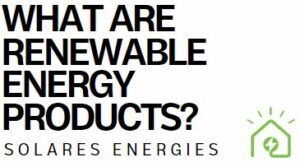 Renewable energy refers to energy sources that are constantly replenished on a human timescale such as sunlight, wind, water, and geothermal heat. These always-generating renewable energy supply sources contrast with finite sources such as fossil fuels which, once consumed, cannot be replaced.
Renewable energy refers to energy sources that are constantly replenished on a human timescale such as sunlight, wind, water, and geothermal heat. These always-generating renewable energy supply sources contrast with finite sources such as fossil fuels which, once consumed, cannot be replaced.
Renewable energy products are technologies and devices that generate power from resources which are naturally replenished on a human timescale. They
harness energy from the sun, wind, water, and organic matter. Here’s a look at some common renewable energy products and how they work:
Solar Panels (Photovoltaics):
How they work: Solar panels convert sunlight into electricity using photovoltaic cells. When sunlight hits a solar panel, it excites electrons in the cells, creating an electric current.
Products: Includes rooftop solar panels for homes and businesses, solar farms, and portable solar chargers.
Wind Turbines:
How they work: Wind turbines use the wind to spin blades connected to a rotor, which turns a generator to produce electricity.
Products: Range from large-scale wind farms to smaller turbines for individual homes or businesses.
Hydroelectric Power Systems:
How they work: These systems generate power from the movement of water. In large-scale installations, dams store water in a reservoir; when released, the water flows through turbines, spinning them to generate electricity.
Products: Include large hydroelectric dams, small run-of-the-river systems, and micro-hydro generators.
Geothermal Systems:
How they work: Geothermal energy harnesses heat from the Earth. In power plants, hot water or steam from underground reservoirs is used to spin turbines and generate electricity. For heating and cooling, geothermal heat pumps use the stable temperature of the ground.
Products: Geothermal power plants, residential ground heat pumps.
Biomass Energy Systems:
How they work: Biomass energy involves burning organic materials (wood, agricultural waste, and even garbage) to produce heat, which is then used to generate electricity. Alternatively, biomass can be converted into biofuels like ethanol or biodiesel.
Products: Biomass burners, residential wood stoves, and biomass boilers
Tidal and Wave Energy Converters:
How they work: These harness the energy from ocean tides and waves. Tidal energy converters use the rise and fall of tides to generate power, while wave converters capture the energy of surface waves.
Products: Tidal barrages, underwater tidal turbines, wave energy converters.
Each of these renewable energy products works by converting natural energy flows into usable electricity, heat, or fuel, offering a sustainable and environmentally friendly alternative to fossil fuels.
The technology and scale of these products can vary widely, from small, personal-use items to large-scale installations powering entire communities.
Renewable energy solutions encompass a range of technologies and devices designed to harness energy from naturally replenishing sources such as the sun, wind, water, and organic matter. These products are essential in the transition towards more sustainable and environmentally friendly energy systems, offering alternatives to traditional fossil fuels.
If you would like to find out more, please complete our online enquiry form and one of the team for Solares Energies, will call you back.

Renewable energy solutions encompass various technologies and methods for harnessing energy from naturally replenishing sources. These solutions are key to sustainable energy production. There are numerous renewable energy solutions for both residential and commercial use, that will not only reduce your carbon footprint but save you thousands on utility bills.
The primary types include:
Solar Energy:
Photovoltaics (PV): Convert sunlight directly into electricity using solar panels.
Concentrated Solar Power (CSP): Use mirrors or lenses to concentrate a large area of sunlight onto a small area, generating heat that drives a power plant.
Wind Energy:
Hydropower:
Geothermal Energy:
Biomass Energy:
Ocean Energy:
Each type of renewable energy solution has its unique mechanisms and is suited for different applications depending on geographical, environmental, and economic factors.
These technologies collectively contribute to reducing dependence on fossil fuels, curbing greenhouse gas emissions, and promoting a sustainable future.
If you would like to find out more, please complete our online enquiry form and one of the team for Solares Energies, will call you back.
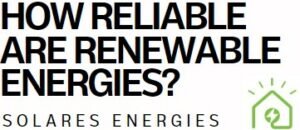 The reliability of renewable energies varies depending on the type of energy source, technological advancements, geographic location, and the integration of these sources into the existing energy grid.
The reliability of renewable energies varies depending on the type of energy source, technological advancements, geographic location, and the integration of these sources into the existing energy grid.
Here’s an overview:
Solar Energy:
Variability: Solar energy is intermittent, as it depends on sunlight, which varies with time of day, weather conditions, and seasons.
Advancements: Technological improvements in photovoltaic cells and the use of battery storage systems have enhanced the reliability of solar energy.
Wind Energy:
Fluctuations: Wind energy is also intermittent. The wind doesn’t always blow consistently, and its strength can vary.
Predictive Technologies: Advanced forecasting techniques and diverse geographic distribution of wind farms can help mitigate variability.
Hydropower:
Stability: Generally more consistent and reliable than solar and wind. Large reservoirs can store water to manage supply.
Environmental and Climatic Factors: Can be influenced by seasonal water flow variations and long-term climate change.
Geothermal Energy:
Consistency: Highly reliable and consistent. The Earth’s heat is a stable energy source, providing a continuous supply of power.
Location Specific: Its feasibility is highly dependent on geological conditions.
Biomass Energy:
Controlled Production: Biomass energy can be produced on demand, unlike solar or wind, making it a more stable and controllable source.
Supply Issues: Dependent on the availability of biomass materials which can be affected by economic and environmental factors.
Ocean Energy:
Predictability: Tidal energy is highly predictable due to the regularity of tidal cycles.
Emerging Technology: Wave and ocean thermal energies are less predictable and still in developmental stages.
Grid Integration and Energy Storage:
The reliability of renewable energy sources is greatly enhanced by integrating them into a diversified energy grid. Using a mix of different renewable sources can balance out the intermittency of individual sources.
Energy storage technologies, like batteries, play a crucial role in storing excess energy when production is high and supplying energy when production is low.
While individual renewable energy sources have their variability, technological advancements, and smart grid integration strategies are improving their overall reliability.
As storage technologies advance and renewable energy infrastructure expands, these sources are becoming increasingly viable as stable, reliable components of energy systems worldwide.
Lifespan of Renewable Energy Solutions
Renewable energy systems are incredibly reliable, often having lifetimes of 25-30 years or longer. Solar energy systems, in particular, have no moving parts, which minimizes the risk of breakdowns and the need for repairs. This reliability, paired with the rising efficiency and falling cost of solar technology, makes renewable energy an increasingly viable option for meeting our energy needs.
If you would like to find out more, please complete our online enquiry form and one of the team for Solares Energies, will call you back.
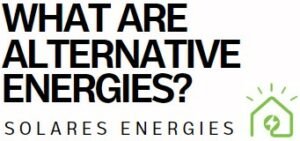
Alternative energies refer to energy sources that are alternatives to traditional fossil fuels (coal, oil, and natural gas), which are the predominant sources of energy globally. These alternative sources are sought after for their potential to provide cleaner, more sustainable, and often renewable forms of energy.
Renewable Energies:
Solar Energy: Harnesses sunlight to generate electricity or heat.
Wind Energy: Utilizes wind to produce electricity.
Hydropower: Generates electricity from flowing water in rivers, streams, or hydroelectric dams.
Geothermal Energy: Uses Earth’s internal heat for heating and power generation.
Biomass: Involves burning organic materials or converting them into biofuels like ethanol or biodiesel.
Nuclear Energy:
Although not renewable, nuclear energy is often considered an alternative energy because it produces large amounts of electricity with low greenhouse gas emissions. It involves the use of nuclear reactions (like fission) to generate heat, which is then used to produce electricity.
Hydrogen Energy:
Hydrogen can be used as a clean fuel source, especially when it is produced from water using renewable energy sources. Fuel cells convert hydrogen into electricity, with water vapour as the only byproduct.
Tidal and Wave Energy:
These are forms of hydropower that use the movement of ocean waters to generate electricity.
Bioenergy with Carbon Capture and Storage (BECCS):
This technology combines biomass energy production with carbon capture and storage, aiming to reduce net carbon emissions.
Alternative energies are increasingly important in global efforts to reduce greenhouse gas emissions, combat climate change, and create a more sustainable and secure energy future.
They are characterized by their potential for sustainability, lower environmental impact, and in many cases, the ability to be replenished naturally.
If you would like to find out more, please complete our online enquiry form and one of the team for Solares Energies, will call you back.
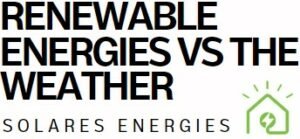 Renewable energy systems are designed to work in a wide range of weather conditions, but their efficiency can be influenced by these conditions. For instance, solar panels function best in direct sunlight and their output can decrease during cloudy or rainy days.
Renewable energy systems are designed to work in a wide range of weather conditions, but their efficiency can be influenced by these conditions. For instance, solar panels function best in direct sunlight and their output can decrease during cloudy or rainy days.
However, they can still produce electricity under these conditions, albeit at a lower rate. Similarly, wind turbines need wind to produce electricity but too much wind can be harmful and result in shutdown to avoid damage.
Solar and Wind Energy Systems
Solar energy systems exhibit peak efficiency under sunny conditions, with their output decreasing on cloudy or rainy days, though they still generate power. Cold temperatures can actually improve their performance, but heavy snowfall can obstruct solar panels, necessitating snow removal to restore functionality. Wind energy systems, on the other hand, depend heavily on wind conditions. They require a certain minimum wind speed to generate electricity and have optimal output under consistent winds. However, in very high winds, turbines may shut down to prevent damage, and during calm periods, they don’t produce energy, necessitating backup or energy storage systems.
Hydropower and Geothermal Systems
Hydropower systems are less affected by daily weather changes but are sensitive to long-term patterns like seasonal water flow and drought conditions. A consistent flow of water is crucial for hydroelectric power, with droughts posing a significant challenge by reducing water levels in reservoirs. Geothermal energy systems are notably weather-independent. Since they rely on the Earth’s internal heat, which remains stable, their performance is consistent and unaffected by surface weather conditions.
Biomass Energy Systems
Biomass energy generation is relatively resilient to weather variations. It relies on burning organic materials, and while its efficiency isn’t significantly impacted by weather changes, the availability of biomass fuel can be influenced by seasonal agricultural cycles or extreme weather events. Overall, each renewable energy system has its unique response to weather conditions, and the efficiency and output can vary accordingly. Integrating a mix of these renewable sources and incorporating energy storage solutions can help in maintaining a steady and reliable energy supply even with weather fluctuations.
At Solares Energies, we use advanced technologies and forecasting methods to optimize renewable energy production, across various weather conditions and ensure system longevity.
If you would like to find out more, please complete our online enquiry form and one of the team for Solares Energies, will call you back.
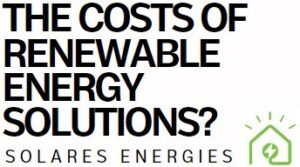 The cost of installing and maintaining a renewable energy system can vary greatly depending on the specific system type, size, and location. We have created a rough guide to the cost of installation.
The cost of installing and maintaining a renewable energy system can vary greatly depending on the specific system type, size, and location. We have created a rough guide to the cost of installation.
This price includes professional installation and connection to the power grid.
Solar Energy Systems:
Installation Costs: Residential solar panel systems can range from €15,000 to €25,000 before incentives. The price depends on the system’s size, the type of panels, and the installation complexity.
Maintenance costs: Solar systems are relatively low due to their lack of moving parts – a regular inspection and cleaning once or twice a year is usually sufficient to keep them operating at peak performance.
Wind Energy Systems:
Small Residential Turbines: These can cost between €3,000 and €8,000 per kilowatt of capacity. A typical home system might be around 5-10 kW.
Maintenance Costs: Maintenance of small turbines can cost around 1-3% of the initial installation cost annually.
Hydropower Systems:
Installation Costs: Micro-hydro systems can vary, but a small system might cost between €1,000 and €20,000, depending on capacity and site specifics.
Maintenance Costs: These systems require regular maintenance, including clearing debris and ensuring mechanical parts function properly, but costs are generally low.
Geothermal Systems:
Installation Costs: Residential geothermal heat pump systems can range from €10,000 to €20,000. The cost is influenced by soil conditions, the system’s size, and the home’s heating and cooling needs.
Maintenance Costs: They are generally low, similar to conventional HVAC systems, but the underground loop system has a long lifespan with minimal maintenance.
These maintenance costs are often offset by long-term energy cost savings, and at Solares Energies, we work with our customers to provide affordable maintenance plans that fit their budgets and needs.
Despite the upfront costs, these systems are designed to last and typically come with warranties of up to 25 years.
If you would like to find out more, please complete our online enquiry form and one of the team for Solares Energies, will call you back.
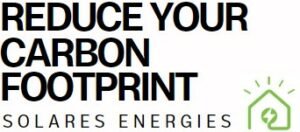 Renewable energy sources, such as solar or wind, do not emit greenhouse gases when generating electricity. By transitioning your energy consumption from fossils to renewables, you can significantly reduce your carbon footprint.
Renewable energy sources, such as solar or wind, do not emit greenhouse gases when generating electricity. By transitioning your energy consumption from fossils to renewables, you can significantly reduce your carbon footprint.
For instance, a typical residential solar panel system can reduce carbon emissions by 3-4 tons annually, equivalent to planting over 100 trees each year. At Solares Energies, we are dedicated to facilitating your transition to clean energy and helping to combat climate change.
Low or Zero Emission: Renewable energy sources like solar, wind, hydro, geothermal, and biomass typically emit far fewer greenhouse gases compared to traditional fossil fuels. Solar and wind energy, in particular, have virtually no emissions during operation.
Displacement of Fossil Fuel Energy: By utilizing renewable energy, you’re reducing the demand for energy produced from fossil fuels. This displacement is crucial since burning coal, oil, and natural gas for electricity and heat is the largest single source of global greenhouse gas emissions.
Sustainable Power Generation: Renewable energy sources are sustainable, meaning they are naturally replenished. This sustainability ensures a long-term, ongoing reduction in carbon emissions compared to finite and carbon-heavy fossil fuels.
Energy Efficiency: Many renewable energy technologies, especially in their latest iterations, are highly efficient in converting natural resources (like sunlight or wind) into energy. Greater efficiency means more energy output for the same environmental impact, further reducing the carbon footprint.
Decentralized Energy Production: Renewable energy, especially solar panels and small wind turbines can be set up locally, even at home. This decentralized energy production reduces the energy lost in transportation (like electricity through long power lines), leading to more efficient energy use and lower carbon emissions.
Lifecycle Emissions: While there are emissions associated with manufacturing and installing renewable energy systems, the total lifecycle emissions are significantly lower compared to traditional energy sources. Over time, the clean energy produced by these systems more than offsets the initial production emissions.
Promoting a Cleaner Environment: Adopting renewable energy can also lead to broader environmental benefits like reduced air and water pollution, contributing to a healthier, more sustainable environment which is indirectly related to the carbon footprint.
By adopting renewable energies, you are not only directly reducing the amount of carbon dioxide and other greenhouse gases released into the atmosphere but also promoting a shift towards a more sustainable and environmentally friendly energy future. This collective effort is crucial in tackling climate change and reducing global carbon footprints.
If you would like to find out more, please complete our online enquiry form and one of the team for Solares Energies, will call you back.
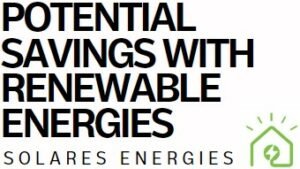 Using renewable energy can result in substantial savings over time, especially considering the increasing cost of non-renewable energy. The exact amount of savings will depend on several factors including your geographical location (and thus the amount of sunlight you receive), the size and efficiency of your solar panel system, your current electricity rates, and how much energy you consume.
Using renewable energy can result in substantial savings over time, especially considering the increasing cost of non-renewable energy. The exact amount of savings will depend on several factors including your geographical location (and thus the amount of sunlight you receive), the size and efficiency of your solar panel system, your current electricity rates, and how much energy you consume.
On average, our customers at Solares Energies see a reduction of between 70-100% on their monthly electricity bills. In many regions, excess energy produced by your solar panels can be sold back to the grid, providing further savings or even profit. Over the lifespan of the system, these savings can add up to thousands of dollars. As energy prices continue to rise, the amount you save will likely increase as well.
The potential savings from using renewable energy sources can be significant, both in financial and environmental terms. These savings vary based on factors like the type of renewable energy system, local energy prices, and incentives. Here’s an overview:
Reduction in Electricity Bills:
Direct Savings: Solar panels and wind turbines can significantly reduce or even eliminate electricity bills. The amount saved depends on the size and efficiency of the system and the household’s energy usage.
Net Metering: In many areas, if your system generates more electricity than you use, you can sell this excess back to the grid, further reducing your energy costs.
Incentives and Tax Credits:
Many governments offer incentives, rebates, or tax credits for installing renewable energy systems, which can offset the initial installation costs.
These incentives can take various forms, such as direct rebates, tax deductions, or feed-in tariffs for excess energy produced.
Stable Energy Costs:
Renewable energy can protect against fluctuating energy prices. Once installed, the cost of generating power from renewable sources remains relatively constant over time, unlike fossil fuels, which can be subject to market volatility.
Long-Term Savings:
Renewable energy systems typically have long lifespans. Solar panels, for example, can last 25-30 years, ensuring long-term savings on energy costs.
Maintenance costs for systems like solar and wind are generally low, contributing to long-term savings.
Increased Property Value:
Homes and buildings with renewable energy systems can see an increase in property value, as energy efficiency and low running costs are attractive features for buyers.
Environmental Savings:
By using renewable energy, you’re reducing the demand for fossil fuels, leading to lower greenhouse gas emissions and a smaller carbon footprint. Over the lifetime of renewable energy systems, this can amount to significant environmental savings in terms of reduced air pollution and contribution to combating climate change.
Savings in Health Costs and Environmental Damage:
Reducing pollution through renewable energy can lead to better overall public health and lower health-related expenses. It also mitigates environmental damage associated with extracting, transporting, and burning fossil fuels.
If you would like to find out more, please complete our online enquiry form and one of the team for Solares Energies, will call you back.
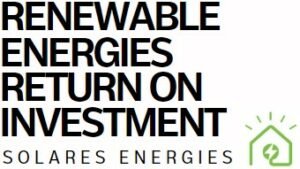 The return on investment (ROI) for a renewable energy system depends on many variables, including the cost of the system, the cost of electricity in your area, the amount of sunlight your area receives, and available local and federal incentives. Generally, the ROI for solar energy systems is quite attractive – most of our customers at Solares Energies see a return on their initial investment in 5-7 years. Once the system has paid for itself, the electricity it generates is essentially free, leading to substantial savings over the system’s lifetime.
The return on investment (ROI) for a renewable energy system depends on many variables, including the cost of the system, the cost of electricity in your area, the amount of sunlight your area receives, and available local and federal incentives. Generally, the ROI for solar energy systems is quite attractive – most of our customers at Solares Energies see a return on their initial investment in 5-7 years. Once the system has paid for itself, the electricity it generates is essentially free, leading to substantial savings over the system’s lifetime.
Solar energy systems can increase property values. A study by the National Renewable Energy Laboratory found that homes with solar panels sell 20% faster and for 17% more money. Given the long lifespan of these systems, the benefits continue to accrue long after the initial investment has been recouped.
The return on investment (ROI) for renewable energy systems in Spain, as in many countries, is influenced by several factors, including the type of renewable energy technology, the scale of the project, government policies, and market conditions.
Solar Energy Projects: Spain has a favourable climate for solar energy, with an abundance of sunlight. Large-scale solar projects are underway, which are expected to significantly contribute to the country’s energy needs. For example, Iberdrola, a major energy company in Europe, is working on developing an extensive network of solar photovoltaic power plants across Spain, Portugal, and Germany. These projects are not only aimed at boosting renewable energy capacity but also at generating employment opportunities, especially in rural areas.
The investment in these solar projects, backed by financial support from entities like the European Investment Bank, underscores the economic viability and potential long-term benefits of renewable energy investments in Spain.
Government Support and Financing: The Spanish government’s commitment to renewable energy is evident in its ambitious plans and targets. The support from the European Investment Bank, with significant loans for renewable energy projects, demonstrates the confidence in the financial viability and positive economic impact of these initiatives.
These investments are part of broader European efforts, like the REPowerEU plan, to reduce dependence on fossil fuels and accelerate the green transition.
Market Trends and Global Investment: Globally, there has been a substantial increase in investment in renewable energy, with significant growth since 2019. This trend is reflective of a broader shift towards sustainable energy solutions. However, it’s important to note that while investment in renewable energy has reached new heights, it still falls short of the levels required to meet global sustainability targets.
This indicates both the challenges and opportunities in the renewable energy sector, including in Spain.
The ROI for renewable energy systems in Spain is influenced by a confluence of factors, including the natural suitability for certain types of renewables (like solar energy), government and financial institution support, and the overall global trend towards increased investment in renewable energy.
While specific ROI figures are dependent on individual project details and market dynamics, the ongoing investment and development in the sector highlight its potential profitability and long-term sustainability.
If you would like to find out more, please complete our online enquiry form and one of the team for Solares Energies, will call you back.
 Solar power is the conversion of energy from sunlight into electricity, either directly using photovoltaics (PV), or indirectly using concentrated solar power (CSP) systems. Solar PV systems generate power by converting sunlight directly into electricity using semiconductor materials such as silicon.
Solar power is the conversion of energy from sunlight into electricity, either directly using photovoltaics (PV), or indirectly using concentrated solar power (CSP) systems. Solar PV systems generate power by converting sunlight directly into electricity using semiconductor materials such as silicon.
On the other hand, CSP systems concentrate the sun’s energy using mirrors or lenses onto a small area, which heats a fluid that is used to produce steam and generate electricity through a turbine.
Photovoltaic (PV) systems consist of solar panels that are made up of a large number of solar cells. These solar cells are made up of semiconductor materials, such as silicon, that absorb photons from sunlight and release electrons.
When these electrons are released, they create an electric current, which can be harnessed and used to power homes, businesses, and other structures.
Solar panels are typically installed on the roof of a building or in an open area, where they can receive direct sunlight. They are connected to an inverter, which converts the DC electricity generated by the solar panels into AC electricity that can be used to power appliances and other electrical devices.
Adding solar battery storage will give you added peace of mind that devices will keep running through the evening time, using the stored solar energy collected, through the day.
If you would like to find out more, please complete our online enquiry form and one of the team for Solares Energies, will call you back.
 Thermal water heating or Solar Thermal is a process that uses solar thermal energy, to heat water. This can be achieved by using solar thermal collectors, which are placed on the roof of a building and absorb sunlight.
Thermal water heating or Solar Thermal is a process that uses solar thermal energy, to heat water. This can be achieved by using solar thermal collectors, which are placed on the roof of a building and absorb sunlight.
This energy is then transferred to a liquid or gas and used to heat water stored in tanks. The heated water can then be used for hot showers, washing dishes, or doing laundry. It is an efficient and cost-effective way to utilize renewable energy for domestic purposes.
There are two main types of solar collectors used in thermal water heating systems: flat-plate collectors and evacuated tube collectors.
Flat-plate collectors are made up of a flat, rectangular box that contains a network of tubes. The tubes are covered with a dark coating that absorbs sunlight and converts it into heat. The heat is then transferred to the water that flows through the tubes.
Evacuated tube collectors, on the other hand, consist of a series of glass tubes that are evacuated of air to reduce heat loss. The tubes contain a copper heat pipe that absorbs sunlight and transfers the heat to the water.
In a typical thermal water heating system, the solar collectors are mounted on the roof or a ground-mounted frame. The water is circulated through the collectors using a pump, which is powered by electricity. The heated water is then stored in a well-insulated tank until it is needed.
To ensure that hot water is always available, many thermal water heating systems have a backup heating source, such as an electric or gas water heater, that can be used on cloudy days or during periods of high electricity demand.
Thermal water heating is a cost-effective and environmentally friendly way of using solar technologies and tidal energy to heat water for homes and businesses. Using solar and tidal energy reduces the reliance on fossil fuels and helps to lower greenhouse gas emissions.
If you would like to find out more, please complete our online enquiry form and one of the team for Solares Energies, will call you back.
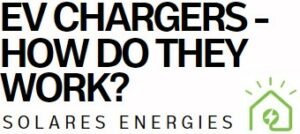 Electric car chargers are devices used to charge the batteries of electric vehicles (EVs). They are typically installed in public locations, such as parking garages, shopping centres, and rest areas, as well as in private locations, such as homes and businesses.
Electric car chargers are devices used to charge the batteries of electric vehicles (EVs). They are typically installed in public locations, such as parking garages, shopping centres, and rest areas, as well as in private locations, such as homes and businesses.
Electric car chargers, or Electric vehicle chargers offer different charging speeds. Here’s how they work:
Level 1 Chargers: These are the basic chargers that can be plugged into a standard household outlet (110-120V). They are relatively slow and typically provide about 4-5 miles of range per hour of charging.
Level 2 Chargers: These chargers require a higher voltage outlet (240V, like the ones used for heavy appliances). They charge much faster than Level 1 chargers, typically offering about 10-60 miles of range per hour of charging.
DC Fast Chargers (Level 3 Chargers): These are the fastest type of chargers and are usually found at public charging stations. They can charge an EV battery to 80% in about 20-30 minutes. However, not all electric cars are compatible with DC Fast Chargers.
Connecting to the EV: To charge an electric car, the charger is connected to the car’s charging port using a compatible connector.
Power Conversion: The charger converts the electrical power from the source (AC power from the grid) to the type needed by the car’s battery (usually DC power). Level 1 and 2 chargers do this conversion inside the car, while DC fast chargers do it inside the charging station.
Communication with the Car: Modern EV chargers and cars communicate to regulate the charging process. This communication ensures the battery is charged safely and efficiently, avoiding overcharging or overheating.
Charging Process: Once connected and communication is established, the charging process begins. The time it takes to fully charge the battery depends on the charger’s speed and the car’s battery capacity.
Installation and Accessibility:
Home Charging: Level 1 and Level 2 chargers can be installed at home. Level 2 chargers, being faster, are a popular choice for home charging, though they may require professional installation.
Public Charging Stations: Public charging stations, often equipped with Level 2 and DC Fast Chargers, are increasingly common in many areas. They are typically located in parking areas, shopping centres, and near major highways.
Electric car chargers are a crucial part of the EV ecosystem, making it convenient to recharge electric vehicles and facilitating the transition away from fossil fuel-dependent transportation.
As the adoption of electric vehicles grows, the availability and technology of EV chargers are also rapidly advancing.
If you would like to find out more, please complete our online enquiry form and one of the team for Solares Energies, will call you back.
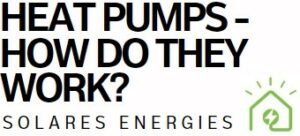 Heat pumps are devices that transfer heat from one location to another, providing a cost-effective and efficient way of heating or cooling buildings. Heat pumps use electricity to move heat, either from the air or ground outside, and transfer it into the home to be used as heating.
Heat pumps are devices that transfer heat from one location to another, providing a cost-effective and efficient way of heating or cooling buildings. Heat pumps use electricity to move heat, either from the air or ground outside, and transfer it into the home to be used as heating.
The process is reversed in the summertime when warm air is taken from the inside and released outdoors, cooling the home in the process.
When heating mode, the heat pump absorbs heat from the outside air, ground, or water and transfers it inside the building. This process is reversed in cooling mode, where the heat pump absorbs heat from inside the building and transfers heat energy from it outside.
The refrigerant is first compressed by the compressor, which increases its temperature and pressure. It then flows through the evaporator, which is located outside the building in space heating-only mode and inside the building in cooling mode.
As the refrigerant evaporates, it absorbs heat from the surrounding air, ground, or water. The resulting gas is then compressed again by the compressor and flows through the condenser, which is located inside the building in heating mode and outside the building in cooling mode.
As the refrigerant condenses, it releases the heat it absorbed earlier into the air or water inside the building. The cycle then repeats itself, with the refrigerant flowing back to the evaporator to absorb more heat.
Heat pumps are highly efficient because they do not generate heat like traditional heating systems, but rather move heat from one location to another. They are also environmentally friendly, as they do not use fossil fuels and can reduce greenhouse gas emissions.
Heat pumps are energy-efficient devices used for heating and cooling spaces. They operate on the principle of heat transfer, rather than generating heat directly. Here’s how they work:
Heat Transfer: Heat pumps move heat from one place to another. In heating mode, they extract heat from outside (even from cold air) and transfer it inside. In cooling mode, they work like an air conditioner, removing heat from inside the building and releasing it outside.
They are suitable for a wide range of climates, though their efficiency can vary depending on external temperatures and specific system design.
Heat pumps are an efficient and environmentally friendly technology for heating and cooling, working on the principle of moving heat rather than generating it. With different types available, they can be adapted to various settings and climatic conditions. Also see Swimming Pool Heat Pumps or Swimming Pool Heaters
If you would like to find out more, please complete our online enquiry form and one of the team for Solares Energies, will call you back.
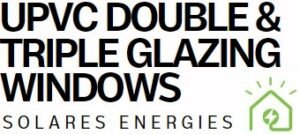 Double and Triple Glazing is a type of window that consists of two panes of glass separated by a gap filled with air or gas. It is designed to provide better insulation and reduce heat loss from a building.
Double and Triple Glazing is a type of window that consists of two panes of glass separated by a gap filled with air or gas. It is designed to provide better insulation and reduce heat loss from a building.
The gap between the two panes of glass acts as an insulating layer, preventing heat from escaping or entering the building. This is because air is a poor conductor of heat, so the trapped air or gas acts as a barrier, reducing the transfer of heat through the window. The thickness of the gap between the two panes of glass can vary from 6 mm to 20 mm or more, depending on the desired level of insulation.
Double and triple glazing are methods used in windows to improve their insulation and energy efficiency. Here’s how they work:
Construction: Double-glazed windows consist of two glass panes separated by a space, typically filled with air or an inert gas like argon.
Function: The trapped air or gas acts as an insulator, reducing heat transfer through the window. This means fewer heat escapes during winter and less heat enters during summer.
Benefits: Double glazing can significantly reduce energy consumption for heating and cooling, leading to lower energy bills. It also helps reduce noise pollution and condensation inside the window.
Construction: Similar to double glazing, but with an additional third layer of glass, creating two insulating spaces instead of one.
Function: The extra pane and air/gas layer enhance the insulating properties of the window. Triple-glazed windows are even more effective at reducing heat transfer than double-glazed windows.
Benefits: Along with even better thermal insulation and energy efficiency, triple glazing offers superior noise reduction. However, they are heavier and more expensive than double-glazed windows.
How They Work:
Thermal Insulation: Both double and triple glazing work by creating a barrier against heat transfer. The air or gas layers between the glass panes reduce the rate at which heat can move in or out of a building.
Reduced Condensation: The inner glass surface is closer to room temperature, reducing the likelihood of condensation compared to single-glazed windows.
Noise Reduction: The multiple layers of glass and air/gas spaces also provide sound insulation, reducing noise from outside.
Double and triple glazing improve the energy efficiency of buildings by providing better thermal insulation. They help maintain a consistent indoor temperature, reduce energy costs, and offer additional benefits like noise reduction and less condensation. Triple glazing offers enhanced performance but at a higher cost and weight compared to double glazing.
uPVC Double glazing also provides other benefits, such as noise reduction and increased security. The two panes of glass can also be coated with a low-emissivity (low-e) coating, which reflects heat into the building and further improves energy efficiency.
Double glazing can be installed in new or existing windows and is available in a range of styles and materials, including uPVC (Unplasticized Polyvinyl Chloride), aluminium, and timber. It is also possible to have triple glazing, which consists of three panes of glass separated by two air or gas gaps, for even greater insulation.
uPVC double glazing Windows are an effective way to improve the energy efficiency of a building, reduce heating costs, and increase comfort levels by minimizing heat loss through windows. – Also see Composite Doors.
If you would like to find out more, please complete our online enquiry form and one of the team for Solares Energies, will call you back.
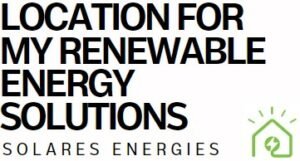 The suitability of a location for renewable energy solutions depends on local climate and geography. For instance, solar systems need ample sunlight, making them ideal for locations with many sunny days.
The suitability of a location for renewable energy solutions depends on local climate and geography. For instance, solar systems need ample sunlight, making them ideal for locations with many sunny days.
Wind turbines need consistent wind speeds, so they’re best for coastal or high-altitude areas. Geothermal systems require certain geological conditions.
As part of our services at Solares Energies, we offer a free site assessment to determine the best renewable energy option for your location.
Analyzing Your Electricity Needs: The first step is to understand your current electricity usage. This involves calculating the electricity needs of your home or business by looking at the wattage and average daily use of all electrical devices. Considering energy efficiency measures can reduce your electricity usage and, consequently, the size and cost of the renewable energy system needed.
Local Codes and Regulations: It’s essential to be aware of any local codes, regulations, or covenants that might affect the installation of renewable energy systems. These can include building codes, zoning laws, and community regulations. They can influence the type of system you are allowed to install, who can install it, and whether you can connect it to the electricity grid or operate it as a stand-alone system.
Renewable Energy Resource Availability: Different renewable energy technologies require specific environmental conditions to be efficient:
Solar Energy: Ideal for locations with abundant sunlight. The Renewable Energy Ready Home (RERH) Solar Site Assessment Tool by ENERGY STAR can guide you in assessing whether a new home has the proper physical orientation to support the installation of a solar energy system. This tool evaluates factors like location, anticipated shading, and roof orientation.
Wind Energy: Suitable for areas with consistent and strong winds. Open fields, high elevations, or coastal areas are often favourable.
Hydropower: Requires proximity to a water source with sufficient flow and drop.
Geothermal: More effective in areas with high geothermal activity.
Grid-Connected or Stand-Alone System: Decide if you want your system to be connected to the electricity grid or operate independently. This decision affects the system type and the additional components needed.
Site-Specific Factors: The suitability of your location for a renewable energy system also depends on factors such as land availability, potential for shading (in the case of solar energy), and local weather patterns.
Professional Assessment: Consulting with a renewable energy company or a local energy office can provide valuable insights. These professionals can help you navigate the specific requirements of your area and suggest the most suitable renewable energy options.
Assessing the suitability of your location for a renewable energy system involves a comprehensive analysis of your energy needs, local codes and regulations, environmental conditions, and specific site characteristics.
Utilising tools like the RERH Solar Site Assessment Tool and consulting with professionals can provide a clearer understanding of the feasibility and type of renewable energy system that would be most effective for your location.
If you would like to find out more, please complete our online enquiry form and one of the team for Solares Energies, will call you back.
 Sadly, there are many companies in Spain, that are not qualified or have the correct knowledge of green renewable energies. At Solares Energies we have created an expert team of electrical engineers, heating and plumbing engineers, gas engineers, and refrigeration engineers. They are fully qualified in their field experience with a wealth of knowledge and experience in renewable energy projects.
Sadly, there are many companies in Spain, that are not qualified or have the correct knowledge of green renewable energies. At Solares Energies we have created an expert team of electrical engineers, heating and plumbing engineers, gas engineers, and refrigeration engineers. They are fully qualified in their field experience with a wealth of knowledge and experience in renewable energy projects.
We pride ourselves on offering exceptional customer service and experience, whilst offering professional advice, based on requirements. If you live in Malaga or Cadiz and you would like to book an appointment to speak to one of the team, please complete the contact form at the top of the page.
Understand Renewable Energy Options: Renewable energy can come from various sources such as solar, wind, hydroelectric, biomass, and geothermal. Familiarize yourself with these sources and how they are utilized to produce electricity. This knowledge will help you in evaluating the options offered by different providers.
Research Providers: Look for energy providers that offer renewable energy options. This could be through direct renewable energy plans or Renewable Energy Credits (RECs). RECs are market-based instruments that represent the property rights to the environmental, social, and other non-power attributes of renewable electricity generation. They are a way for consumers to support renewable energy generation, even if the physical electricity they use comes from a different source.
Check for Third-Party Certification: To ensure that the green power you’re purchasing is genuinely renewable, look for providers whose energy is third-party certified. This certification guarantees that the energy meets nationally accepted environmental standards for resource and product quality and content.
Explore Various Programs: Depending on your location, you may have access to different programs for purchasing renewable energy:
Green Pricing: Some utilities offer an optional service called green pricing, allowing customers to pay a premium for electricity generated from renewable sources.
Competitive Electricity Markets: In deregulated areas, you can choose not only how your electricity is generated but also who generates it. Clean power generators in these markets sell renewable energy products to residential and commercial customers.
Community Choice Aggregation: In some states, local governments can purchase power on behalf of their residents from alternative green power suppliers.
Shared or Community Renewables: This allows individuals to buy, lease, or subscribe to a portion of a shared renewable energy system, such as community solar or wind farms.
Evaluate the Impact: Signing up for a renewable energy plan supports the growth of the renewable industry and helps in moving towards a greener future. Renewable power is essential for reducing dependence on unsustainable resources and minimizing environmental damage.
Consider Practicality and Cost: If personal installation of renewable sources like solar panels is impractical due to high costs or geographic limitations, switching to a renewable plan can be a more feasible way to support green energy.
Provider Examples: Some examples of renewable energy electricity providers include Constellation, Direct Energy, Tomorrow Energy, TriEagle Energy, Spark Energy, and GoodCharlie.
Each provider may offer different energy options and serve different areas, so it’s important to research and find the one that best suits your needs.
If you would like to find out more, please complete our online enquiry form and one of the team for Solares Energies, will call you back.
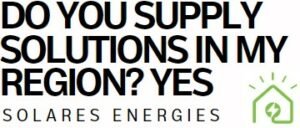 Can I save money on energy bills using renewable energies?
Can I save money on energy bills using renewable energies?The simple answer to whether renewable energy can save money on energy bills for both homes and businesses is a resounding yes. Embracing renewable energy sources like solar panels, wind turbines, or biomass systems can lead to significant financial savings alongside contributing to environmental sustainability.
Homeowners investing in renewable energy systems can enjoy reduced utility bills over the long term. The initial setup cost is offset by the substantial savings accrued from lower energy consumption. Additionally, with systems like solar panels, homeowners can potentially earn money through schemes like the Smart Export Guarantee (SEG), where excess energy generated can be sold back to the grid. This not only provides an additional income stream but also helps in recovering the initial investment quickly.
Similarly, businesses can reap substantial financial benefits from renewable energy. Apart from slashing energy costs, renewable installations like solar arrays can turn into profitable investments. Surplus energy can be sold back to the grid, providing an additional revenue stream and offsetting installation costs. Businesses can also benefit from improved stakeholder confidence as customers, partners, and investors increasingly favour companies with a strong commitment to sustainability.
Moreover, both homes and businesses can protect themselves from volatile energy prices. Owning renewable energy resources shields against unpredictable fluctuations in energy costs, providing more stability in financial planning and budgeting.
Switching to renewable energy is not just about immediate savings; it’s about securing financial and environmental well-being for the future. In times of economic uncertainty, the efficiency and predictability of renewable energy can be vital for the survival and growth of businesses, as well as for the long-term financial health of households.
At Solares Energies, our expert consultants are ready to guide you through making informed renewable energy choices that enhance productivity, cut costs, and minimize environmental impact. Contact us today to explore how renewable energy can transform your energy consumption and create a more sustainable, financially stable future for your home or business.
 Do you support both residential and commercial customers?
Do you support both residential and commercial customers?At Solares Energies, we are dedicated to providing comprehensive renewable energy solutions to both residential and commercial clients. Our services encompass the supply, installation, maintenance, and servicing of a wide range of high-quality, eco-friendly products. Among our offerings, the most popular include solar panel systems, solar battery storage, heat pump systems, and electric vehicle (EV) car chargers.
Solar Panel Systems: Our solar panels are designed to harness the power of the sun efficiently, providing a clean, renewable source of energy for your home or business. We offer customised solar solutions to fit various roof types and energy needs.
Solar Battery Storage: To maximise the benefits of solar energy, we provide advanced solar battery storage systems. These systems store excess solar power for use during non-sunny periods, ensuring a constant energy supply and greater independence from the grid.
Heat Pump Systems: Our heat pump solutions offer an environmentally friendly alternative for heating and cooling your premises. Utilising the natural warmth of the air or ground, our heat pumps deliver efficient temperature control while reducing energy consumption and costs.
EV Car Chargers: With the growing shift towards electric vehicles, we offer state-of-the-art EV car chargers. These charging stations are not only convenient but also incorporate smart technology for efficient energy usage, making them a perfect addition to modern homes and businesses.
Committed to Excellence: At Solares Energies, we take pride in the quality of our products and the professionalism of our services. From initial consultation to post-installation support, our team of skilled professionals is dedicated to ensuring customer satisfaction and helping you transition seamlessly to renewable energy.
Whether you are a homeowner seeking to reduce your carbon footprint or a business aiming to incorporate sustainable practices, Solares Energies is your trusted partner in renewable energy solutions.

At Solares Energies, we specialise in a comprehensive range of renewable energy solutions, catering to both residential and commercial needs. Our offerings include cutting-edge air conditioning systems, solar panel installations, solar battery storage, and a variety of heat pump options including ground, air, and water source systems. We also provide solar thermal water heating, solar carports, electric car chargers, and energy-efficient boiler systems.
Our services extend to high-quality windows, doors, and underfloor heating and cooling systems, all designed to enhance your living or working environment while promoting sustainability and energy efficiency. Let Solares Energies be your partner in transitioning to a greener, more sustainable future.
Air Conditioning Systems
Discover a new level of comfort with our energy-efficient air conditioning systems. Perfect for both homes and businesses, these systems offer superior climate control while reducing your carbon footprint.
Solar Panel Systems
Harness the power of the sun with our state-of-the-art solar panel systems. Ideal for reducing energy bills and increasing sustainability, our solar solutions are customisable to your specific needs.
Solar Battery Storage
Maximise your solar investment with our advanced solar battery storage systems. Store excess solar energy for use anytime, ensuring a continuous power supply and enhanced energy independence.
Solar Thermal Water Heating
Experience efficient water heating with our solar thermal systems. Utilising solar energy, these systems provide a cost-effective solution for hot water needs in residential and commercial settings.
Solar Carports
Protect your vehicle and generate electricity with our innovative solar carports. These dual-purpose structures offer convenient parking while powering your home or business.
Electric Car Chargers
Join the electric revolution with our EV car chargers. Designed for fast and efficient charging, these chargers are an essential addition for electric vehicle owners.
Heat Pumps
Enjoy efficient heating and cooling with our versatile heat pump systems. These eco-friendly solutions provide a comfortable environment year-round, with reduced energy costs.
Ground Source Heat Pump
Tap into the earth’s natural heat with our ground source heat pumps. Ideal for large-scale heating and cooling, these systems offer remarkable efficiency and sustainability.
Air Source Heat Pump
Leverage the air’s thermal energy for your heating needs with our air-source heat pumps. Perfect for moderate climates, they offer an energy-efficient solution for your home or business.
Water Source Heat Pump
Utilise water bodies for efficient thermal energy with our water source heat pumps. These systems are an ideal choice for properties near water sources, offering efficient heating and cooling.
Swimming Pool Heat Pump
Extend your swimming season with our swimming pool heat pumps. Designed for maximum efficiency, these pumps ensure your pool is always at the perfect temperature.
Boiler Systems
Discover reliable and efficient heating with our range of boiler systems. From traditional to biomass boilers, we offer solutions that meet your heating requirements while being environmentally friendly.
Windows & Doors
Upgrade to energy-efficient windows and doors. Our double and triple-glazed solutions improve insulation, reduce energy costs, and enhance the aesthetic of your property.
Underfloor Heating and Cooling
Experience the luxury of underfloor heating and cooling systems. These systems provide even temperature distribution, making them a comfortable and efficient choice for your home or office.
At Solares Energies, we are committed to providing innovative and sustainable solutions for your energy needs. Contact us today to learn more about how we can help you transition to a greener future.
![]() Ground Source Heat Pump
Ground Source Heat Pump
 Looking for the best Renewable Energies Spain has to offer, then look no further. Solares Energies, headquartered in Pueblo Nuevo, Sotogrande, Cadiz, offers a wide range of renewable energy products and solutions primarily throughout Malaga and Cadiz.
Looking for the best Renewable Energies Spain has to offer, then look no further. Solares Energies, headquartered in Pueblo Nuevo, Sotogrande, Cadiz, offers a wide range of renewable energy products and solutions primarily throughout Malaga and Cadiz.
Our services include innovative and sustainable energy solutions that cater to both residential and commercial needs.
As part of its expansion, Solares Energies is actively engaging with new installation partners across all areas of Andalusia and Spain. This strategic move indicates their commitment to broadening the accessibility and implementation of renewable energy solutions nationwide, reflecting an increasing demand for sustainable energy sources nationwide.
This expansion not only demonstrates Solares Energies’ growth but also highlights the increasing significance of renewable energy solutions in Spain’s effort towards a more sustainable and environmentally friendly future.
Alameda, Alcaucín, Alfarnate, Alfarnatejo, Algarrobo, Algatocín, Alhaurín de la Torre, Alhaurín el Grande, Almáchar, Almargen, Almogía, Álora, Alozaina, Alpandeire, Antequera, Árchez, Archidona, Ardales, Arenas, Arriate, Atajate, Benadalid, Benahavís, Benalauría, Benalmádena, Benamargosa, Benamocarra, Benaoján, Benarrabá, El Borge, El Burgo, Campillos, Canillas de Aceituno, Canillas de Albaida, Cañete la Real, Carratraca, Cartajima, Cártama, Casabermeja, Casarabonela, Casares, Coín, Colmenar, Comares, Cómpeta, Cortes de la Frontera, Cuevas Bajas, Cuevas de San Marcos, Cuevas del Becerro, Cútar, Estepona, Faraján, Frigiliana, Fuengirola, Fuente de Piedra, Gaucín, Genalguacil, Guaro, Humilladero, Igualeja, Istán, Iznate, Jimera de Líbar, Jubrique, Júzcar, Macharaviaya, Málaga (city), Manilva, Marbella, Mijas, Moclinejo, Mollina, Monda, Montecorto, Montejaque, Nerja, Ojén, Parauta, Periana, Pizarra, Pujerra, Rincón de la Victoria, Riogordo, Ronda, Salares, Sayalonga, Sedella, Serrato, Sierra de Yeguas, Teba, Tolox, Torremolinos, Torrox, Totalán, Valle de Abdalajís, Vélez-Málaga, Villanueva de Algaidas, Villanueva de la Concepción, Villanueva de Tapia, Villanueva del Rosario, Villanueva del Trabuco, Viñuela, and Yunquera.
Alcalá de los Gazules, Alcalá del Valle, Algar, Algeciras, Algodonales, Arcos de la Frontera, Barbate, Los Barrios, Benalup-Casas Viejas, Benaocaz, Bornos, El Bosque, Cádiz (city), Castellar de la Frontera, Chiclana de la Frontera, Chipiona, Conil de la Frontera, Espera, Grazalema, Jerez de la Frontera, Jimena de la Frontera, La Línea de la Concepción, Medina-Sidonia, Olvera, Paterna de Rivera, Prado del Rey, Puerto de Santa María (El), Puerto Real, Puerto Serrano, Rota, San Fernando, San José del Valle, San Roque, Sanlúcar de Barrameda, Setenil de las Bodegas, Tarifa, Torre Alháquime, Trebujena, Ubrique, Vejer de la Frontera, Villaluenga del Rosario, Villamartín, Zahara de la Sierra, and Zahara de los Atunes.
Don’t worry, if your area is not listed, we’ll still be able to help. Please contact us and speak to one of our team.
![]() Written By:
Written By:
Wesley Lally
![]() Updated on:
Updated on:
29th March 2024

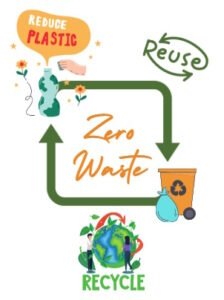

Whether you’re living full-time in Spain or using your property as a holiday home or rental, upgrading a home on the Costa del Sol comes

Air conditioning is now an essential feature of modern living, providing much-needed comfort during scorching summers and in increasingly warmer climates. However, behind the cool

A Greener Gibraltar | Gibraltar’s stunning natural beauty and unique environment make it a place worth protecting. As the world faces the pressing challenges of